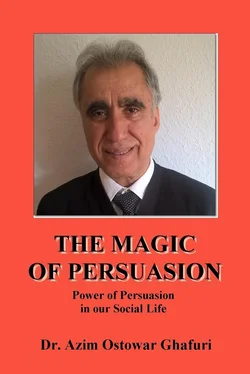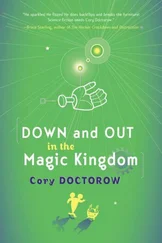Dr. Azim Ostowar Ghafuri - THE MAGIC OF PERSUASION
Здесь есть возможность читать онлайн «Dr. Azim Ostowar Ghafuri - THE MAGIC OF PERSUASION» — ознакомительный отрывок электронной книги совершенно бесплатно, а после прочтения отрывка купить полную версию. В некоторых случаях можно слушать аудио, скачать через торрент в формате fb2 и присутствует краткое содержание. Жанр: unrecognised, на немецком языке. Описание произведения, (предисловие) а так же отзывы посетителей доступны на портале библиотеки ЛибКат.
- Название:THE MAGIC OF PERSUASION
- Автор:
- Жанр:
- Год:неизвестен
- ISBN:нет данных
- Рейтинг книги:4 / 5. Голосов: 1
-
Избранное:Добавить в избранное
- Отзывы:
-
Ваша оценка:
- 80
- 1
- 2
- 3
- 4
- 5
THE MAGIC OF PERSUASION: краткое содержание, описание и аннотация
Предлагаем к чтению аннотацию, описание, краткое содержание или предисловие (зависит от того, что написал сам автор книги «THE MAGIC OF PERSUASION»). Если вы не нашли необходимую информацию о книге — напишите в комментариях, мы постараемся отыскать её.
Persuasion has a very big rule in this changes. As the previous mighty totalitarian regimes in some countries changes to new market-oriented values. It is important and interessting for political parties,advertisers,students, public relation departments and many other people to learn and understand the virous methods and mechanism of the magic persuasion in the daily life of people.
THE MAGIC OF PERSUASION — читать онлайн ознакомительный отрывок
Ниже представлен текст книги, разбитый по страницам. Система сохранения места последней прочитанной страницы, позволяет с удобством читать онлайн бесплатно книгу «THE MAGIC OF PERSUASION», без необходимости каждый раз заново искать на чём Вы остановились. Поставьте закладку, и сможете в любой момент перейти на страницу, на которой закончили чтение.
Интервал:
Закладка:
This is entirely appropriate, because at their prevent stage of development the social sciences cannot provide precise guidance for professional specialists in these fields. Much of the persuasion process remains an art; experience and creation imagination are often the most accurate guides to successful action.
The social sciences can, however, be useful as a supplement to experience. They can help to suggest new questions. That the practitioner should ask about situations confronting him; they can provide categories for codifying experience so that it will be more easily accessible; and they can assist in relating one body of experience to another.
EXAMPLES OF PERSUASION EFFECT AND NON-EFFECT
The files of advertisers, public relations practitioner, propagandists, broadcasters and opinion researchers are full of examples of the massive effects that mass media or gossip can have. Numerous experimental studies have found sweeping changes in attitudes following ex-pure to persuasions for example:
A women's magazine surveyed its readers to find how many of them were paying attention to a column on beauty tips and household matters. It was found that two million women followed the suggestion, recently given in this column, that they put their feet up for a few minutes at intervals throughout the day.
An experiment at the University of Iowa found newspaper editorials extremely effective in influencing student’s attitudes toward a former prime minister of Australia. Almost 100 percent of students who read „planted“editorials in the campus newspaper favouring Mr. Hughes and shifted their attitudes in a positive direction.
Nearly three-quarters of the wartime audience that saw a film about conditions in Naples changed their opinions about the advisability of sending food to Italy.
(Hovland I.C., Janis L.I., Kelley H.H., Communication and Persuasion; New Haven 1959)
By way of contrast, a great many instances can be found of occasions on which extensive advertising or propaganda campaigns seem to have had very little effect or no effect at all. For example: An all-out effort was made by a group of organizations in Cincinnati, Ohio, to acquaint the citizens of that city with facts about the United Nations. In spite of the full cooperation of mass media, advertisers and civic organizations during six months period of the campaign the survey showed that the campaign failed to raise the level of information of the people about the United Nations appreciably. Before the campaign 30 percent of the Cincinnati population had to be classified as knowing nothing about the United Nations and after the campaign the figure was only 28 percent.
A similar experiment on a smaller scale was conducted by a German opinion research institute in cooperation with the Stuttgart radio station. During a period of two years the station took every opportunity to familiarize its listeners with the name and compositions of the upper house of the German Federal Legislature (the Bundesrat), which previous research had shown could be identified correctly by only 10 percent of the audience. After one year and again after the second year, further surveys showed that there was no change in the proportion of the listeners who would correctly identify the Bundesrat.
A publisher who was favourably impressed with the sales of new book shortly after publication decided that with vigorous promotion it might be lifted to the ranks of bestsellers. He therefore greatly increased his advertising budget for the book, only to see sales drop precipitously during the following weeks.
As these examples suggest, there is no clear correlation between ex pure to an idea and its impact on knowledge, attitude or behaviour. No matter how intensive persuasion seems to be from the point of view of the persuader, there is no guarantee that it will have desired effect or indeed that it will have any effect at all.
Many professional and non-professional persuaders recognize this and therefore try to gauge the probable effect of the ideas they want to transmit by putting themselves in the place of the audience and asking such questions as: „How would I react to this message it I were on the receiving end?“
The process of getting inside someone else's skin and using someone else's head is a very difficult one and is rarely completely successful. It can, however, be somewhat facilitated if the persuader tries to understand the motivation of his audience and the ways in which the ideas he is transmitting will be useful to them. To this end he may ask: „If I were a member of the audience, how could I use this message? How would it help me do things I want to do“?
In short, he should know as much as possible about the needs of the people he is addressing and how they are trying to satisfy these needs. It may therefore be helpful to explain shortly in this stage, the basic needs human beings experience and how they shape their behaviour in an effort to achieve their goals.
THE SATISFACTION OF NEEDS
Nearly all actions a person takes can ultimately be traced to an effort to satisfy some basic want or need. There is imperfect agreement as to what these basic needs are, but in general human beings seek physical and mental well-being, affection, respect, skill, knowledge, security and power. The importance attached to each of these values varies from individual to individual and from society to society, but most people seem to want all of them to a greater or lesser degree.
To satisfy his basic needs, a person must manipulate his environment or must adjust to it in some appropriate way. Some needs can be satisfied by the physical environment, which can provide many of the things needed for well-being and security, but others depend largely on the social environment – that is on other people. The degree to which anyone achieves affection, respect and most form of power depends on those around him. Anyone sets certain intermediate goals and prescribes actions that are likely to help him reaches these goals. For reaching these goals, an individual must behave in certain ways with respect to both his physical and his social environment.
Already – formed attitudes govern much of what we say to peoples and how we respond to the varied situations with which we are confronted. Much of our past experience is thus stored in the form of attitudes and habits and they provide a convenient guidance mechanism.
An important characteristic of the habits and attitudes of any single individual is that they must be reasonably harmonious. If a person has to attitudes toward two different types of actions he finds himself in a comfortable position. The man who cannot decide whether to fight or to run away is likely to achieve neither honour nor safety. People therefore try to avoid learning incompatible habits and attitudes.
INFORMATION AND ENVIRONMENT
If our physical and social environments were completely stable, it is theoretically possible that we could learn all that was necessary during our early years and then require very little in the way of new information. That is, once having acquired appropriate habits, attitudes and facts and having shaped these into a harmonious whole, we could then act in such a way as to satisfy our needs without further learning. This, however, is impossible because the environment never is completely stable.
In our complex society, a prodigious amount of new information about both people and things has to be learned every day if we are to guide our actions appropriately. Much of this information we gain from direct observation and more from person-to-person conversation. But most people rely on the mass media, directly or indirectly, to inform themselves many aspects of the social and physical environment that are important to them. Businessmen keep in touch with political and economic developments through the press, radio and TV in order to guide their day-to-day decision; others may inform themselves about the world of sports and use this information in conservation with their friends. And so that the mass media cater to so many needs and serve so many functions that is difficult to disentangle the various uses that different people make of them.
Читать дальшеИнтервал:
Закладка:
Похожие книги на «THE MAGIC OF PERSUASION»
Представляем Вашему вниманию похожие книги на «THE MAGIC OF PERSUASION» списком для выбора. Мы отобрали схожую по названию и смыслу литературу в надежде предоставить читателям больше вариантов отыскать новые, интересные, ещё непрочитанные произведения.
Обсуждение, отзывы о книге «THE MAGIC OF PERSUASION» и просто собственные мнения читателей. Оставьте ваши комментарии, напишите, что Вы думаете о произведении, его смысле или главных героях. Укажите что конкретно понравилось, а что нет, и почему Вы так считаете.












